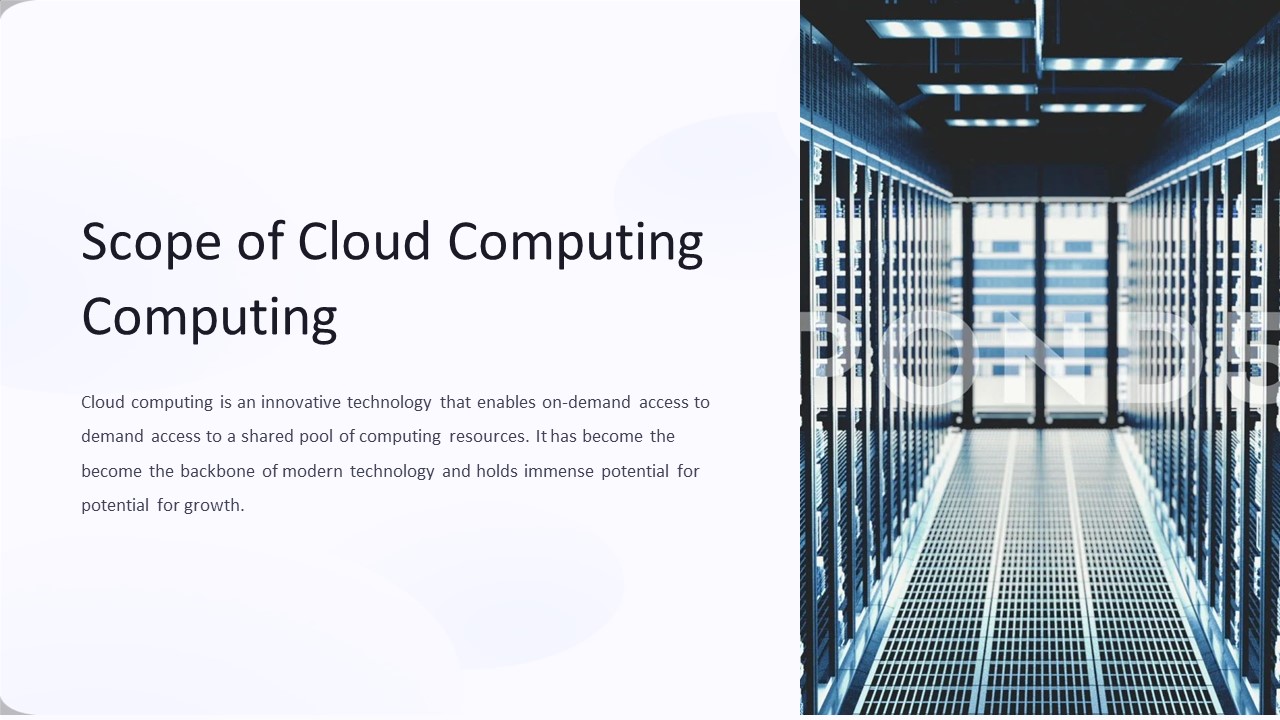Scope of Cloud Computing - PowerPoint PPT Presentation
Title:
Scope of Cloud Computing
Description:
Cloud computing is a type of computer technology that allows people to access shared computer resources, such as computing, storage, and applications, through internet-connected devices. These resources can then be used on demand for both business and personal purposes. – PowerPoint PPT presentation
Number of Views:1
Title: Scope of Cloud Computing
1
Scope of Cloud Computing
Cloud computing is an innovative technology that
enables on-demand access to a shared pool of
computing resources. It has become the backbone
of modern technology and holds immense potential
for growth.
2
Definition of Cloud Computing
1
Cloud Services
Cloud computing refers to the delivery of
computing services such as storage, servers,
databases, and software over the internet (the
cloud) on a pay-per-use basis.
2
Demand-based resource allocation
Cloud computing allows the distribution of
computing resources to users on-demand.
3
Scalability and Flexibility
It provides the option to scale services up or
down based on the user's requirements. This leads
to cost-saving and more flexible workloads.
3
Types of Cloud Computing
Public Cloud
Private Cloud
Hybrid Cloud
Services are available to anyone on the internet.
They are hosted and managed by third-party
providers.
A private cloud is used by a single organization
and is hosted within their data center or
on-premise.
It's a combination of public and private clouds
that remain distinct entities but are bound
together by standard technology enabling data and
application portability.
4
Advantages of Cloud Computing
Flexibility Scalability
Easy Access Collaboration
Reliability Security
Cloud computing enables companies to scale
resources as per the requirements, making it
cost-effective and more flexible compared to
traditional on-site hosting.
Access to data and applications from anywhere in
the world and the ability to share data in
real-time with team members enables better
communication and collaboration, hence improving
productivity.
Cloud service providers have high-level security
measures in place, redundancy, and reliable
backups to ensure data is secure and not
vulnerable to data loss.
5
Challenges of Cloud Computing
Dependency on internet connectivity
A reliable internet connection is necessary to
access and use cloud computing services. Network
outages and loss of internet connectivity can
cause disruption and delays.
1
2
3
Security
Compatibility Issues
Cloud computing is vulnerable to security risks
as sensitive data is stored over the internet.
Organizations should adopt certain safety
measures like encryption, anti-virus software and
firewalls to avoid data loss, hacking or other
security breaches.
Cloud services are built using different
technologies, making it difficult to ensure
compatibility with legacy systems. Migration to
the cloud may, therefore, take time, involve a
cost, and present compatibility issues.
6
Current Trends in Cloud Computing
Edge computing
Serverless Computing
Hybrid Cloud Adoption
Edge computing pushes the processing of data and
services to the edge of the network it gets
treated locally rather than in a centralized
cloud data center. This makes it faster,
reliable, and more secure.
Serverless computing enables developers to write
code that executes based on predefined triggers
without worrying about the infrastructure setup,
maintenance of physical servers, or updates.
The adoption of the hybrid cloud architecture has
seen significant growth due to its scalability
and support of a wide range of use cases,
capabilities, and requirements.
7
Conclusion
Cloud computing has become an essential part of
the technology industry, providing major benefits
to both businesses and consumers. Proper
implementation, integration, and maintenance of
cloud infrastructures can lead to cost savings,
competitive advantage, and efficiency.































